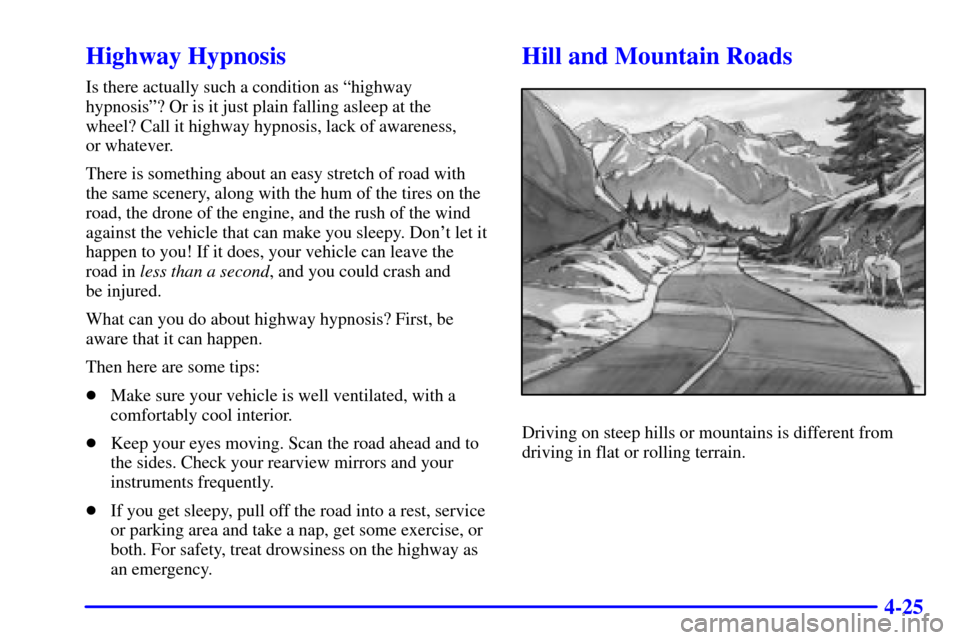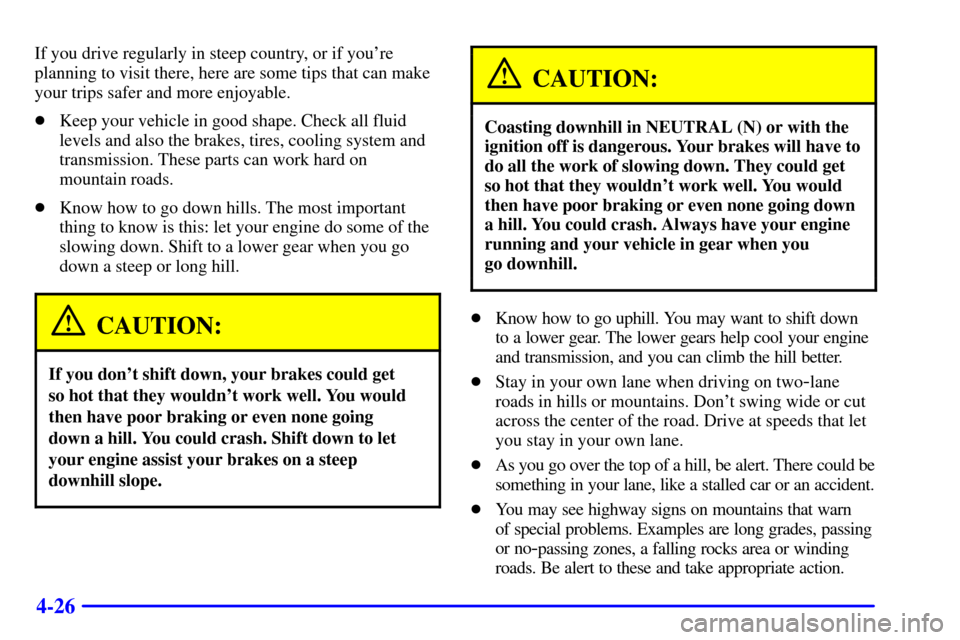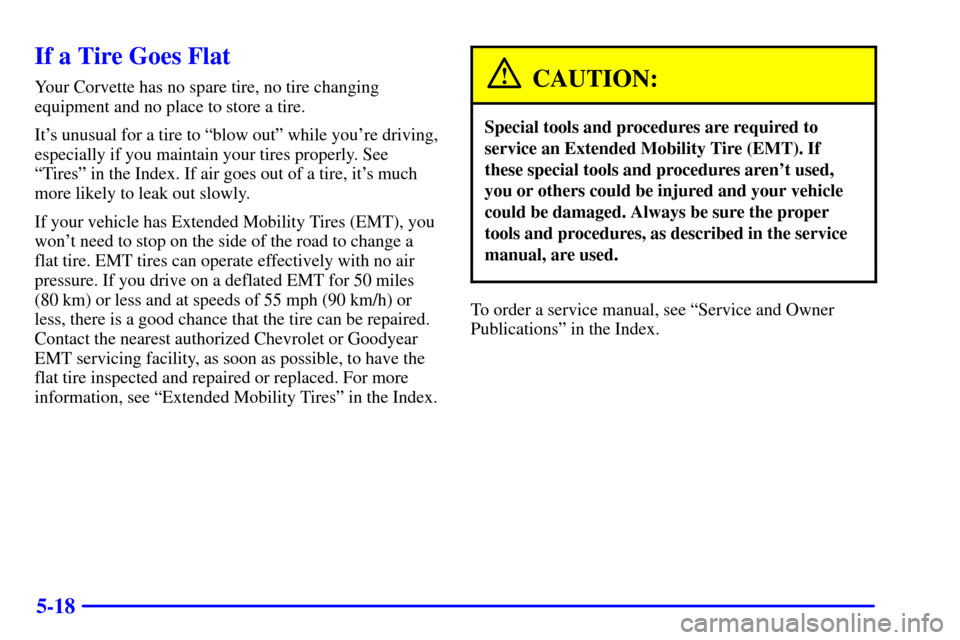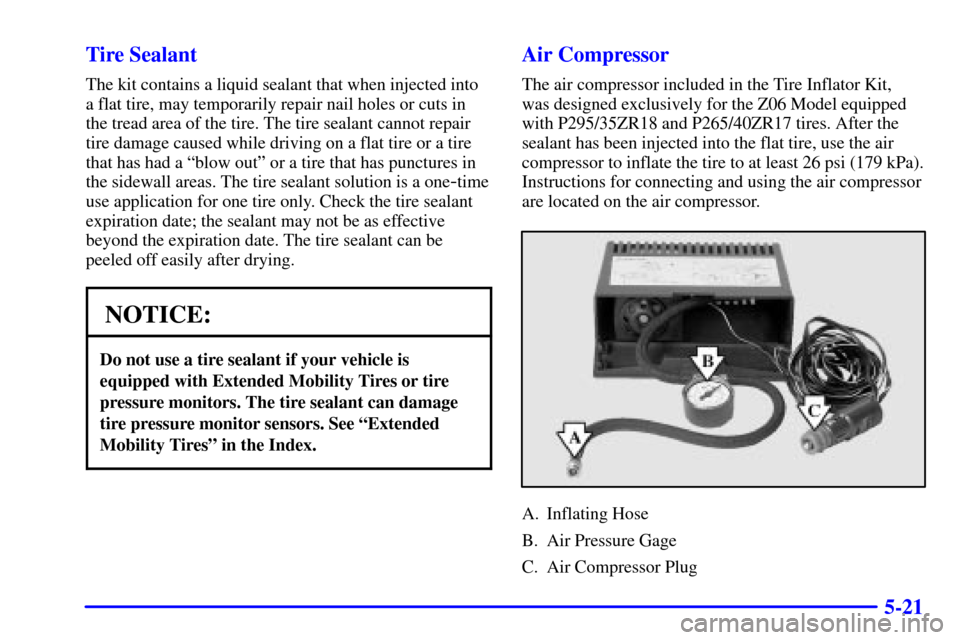Page 235 of 383

4-25
Highway Hypnosis
Is there actually such a condition as ªhighway
hypnosisº? Or is it just plain falling asleep at the
wheel? Call it highway hypnosis, lack of awareness,
or whatever.
There is something about an easy stretch of road with
the same scenery, along with the hum of the tires on the
road, the drone of the engine, and the rush of the wind
against the vehicle that can make you sleepy. Don't let it
happen to you! If it does, your vehicle can leave the
road in less than a second, and you could crash and
be injured.
What can you do about highway hypnosis? First, be
aware that it can happen.
Then here are some tips:
�Make sure your vehicle is well ventilated, with a
comfortably cool interior.
�Keep your eyes moving. Scan the road ahead and to
the sides. Check your rearview mirrors and your
instruments frequently.
�If you get sleepy, pull off the road into a rest, service
or parking area and take a nap, get some exercise, or
both. For safety, treat drowsiness on the highway as
an emergency.
Hill and Mountain Roads
Driving on steep hills or mountains is different from
driving in flat or rolling terrain.
Page 236 of 383

4-26
If you drive regularly in steep country, or if you're
planning to visit there, here are some tips that can make
your trips safer and more enjoyable.
�Keep your vehicle in good shape. Check all fluid
levels and also the brakes, tires, cooling system and
transmission. These parts can work hard on
mountain roads.
�Know how to go down hills. The most important
thing to know is this: let your engine do some of the
slowing down. Shift to a lower gear when you go
down a steep or long hill.
CAUTION:
If you don't shift down, your brakes could get
so hot that they wouldn't work well. You would
then have poor braking or even none going
down a hill. You could crash. Shift down to let
your engine assist your brakes on a steep
downhill slope.
CAUTION:
Coasting downhill in NEUTRAL (N) or with the
ignition off is dangerous. Your brakes will have to
do all the work of slowing down. They could get
so hot that they wouldn't work well. You would
then have poor braking or even none going down
a hill. You could crash. Always have your engine
running and your vehicle in gear when you
go downhill.
�Know how to go uphill. You may want to shift down
to a lower gear. The lower gears help cool your engine
and transmission, and you can climb the hill better.
�Stay in your own lane when driving on two
-lane
roads in hills or mountains. Don't swing wide or cut
across the center of the road. Drive at speeds that let
you stay in your own lane.
�As you go over the top of a hill, be alert. There could be
something in your lane, like a stalled car or an accident.
�You may see highway signs on mountains that warn
of special problems. Examples are long grades, passing
or no
-passing zones, a falling rocks area or winding
roads. Be alert to these and take appropriate action.
Page 238 of 383

4-28 Driving on Snow or Ice
Most of the time, those places where your tires meet the
road probably have good traction.
However, if there is snow or ice between your tires
and the road, you can have a very slippery situation.
You'll have a lot less traction or ªgripº and will need
to be very careful.
What's the worst time for this? ªWet ice.º Very cold
snow or ice can be slick and hard to drive on. But wet
ice can be even more trouble because it may offer the
least traction of all. You can get wet ice when it's about
freezing (32�F; 0�C) and freezing rain begins to fall.
Try to avoid driving on wet ice until salt and sand crews
can get there.
Whatever the condition
-- smooth ice, packed, blowing
or loose snow
-- drive with caution.
Keep your traction control system on. It improves your
ability to accelerate when driving on a slippery road.
Even though your vehicle has the TCS system, you'll
want to slow down and adjust your driving to the road
conditions. If your vehicle has the optional Active
Handling System, it may also activate. See ªTraction
Control Systemº and ªActive Handling Systemº in
the Index.
Page 261 of 383

5-18
If a Tire Goes Flat
Your Corvette has no spare tire, no tire changing
equipment and no place to store a tire.
It's unusual for a tire to ªblow outº while you're driving,
especially if you maintain your tires properly. See
ªTiresº in the Index. If air goes out of a tire, it's much
more likely to leak out slowly.
If your vehicle has Extended Mobility Tires (EMT), you
won't need to stop on the side of the road to change a
flat tire. EMT tires can operate effectively with no air
pressure. If you drive on a deflated EMT for 50 miles
(80 km) or less and at speeds of 55 mph (90 km/h) or
less, there is a good chance that the tire can be repaired.
Contact the nearest authorized Chevrolet or Goodyear
EMT servicing facility, as soon as possible, to have the
flat tire inspected and repaired or replaced. For more
information, see ªExtended Mobility Tiresº in the Index.CAUTION:
Special tools and procedures are required to
service an Extended Mobility Tire (EMT). If
these special tools and procedures aren't used,
you or others could be injured and your vehicle
could be damaged. Always be sure the proper
tools and procedures, as described in the service
manual, are used.
To order a service manual, see ªService and Owner
Publicationsº in the Index.
Page 262 of 383

5-19
Z06 models do not have Extended Mobility Tires. If a
Z06 model tire goes flat, avoid further tire and wheel
damage by driving slowly to a level place and stopping.
Then do this:
1. Turn on the hazard warning flashers.
2. Set the parking brake firmly.
3. Put the shift lever (manual transmission)
in REVERSE (R).
4. Turn off the engine.
5. Inspect the flat tire.
If the tire has been separated from the wheel or has
damaged sidewalls or large tears that allow rapid air
loss, call a tire repair facility. See ªRoadside Assistanceº
in the Index.
If the flat tire is due to a slow leak caused by a nail or
other similar road hazard, the Tire Inflator Kit may be
used to repair the damaged tire temporarily. The kit uses
a liquid tire sealant to seal small punctures in the tread
area of the tire. The flat tire is then inflated to at least
26 psi (179 kPa) and driven to evenly distribute the tiresealant. The tire pressure is checked after driving for a
maximum of 10 minutes to see if the slow leak has been
stopped. If the tire pressure is 19 psi (131 kPa) or more,
inflate the tire up to the standard operating pressure as
shown on the Tire Pressure Label found on the rear edge
of the driver's door. See ªTires, Pressureº in the Index.
You should have the damaged tire repaired as soon as
possible. The tire sealant is a temporary repair only.
For more information regarding the tire inflator kit see
ªTire Inflator Kitº following this section.
NOTICE:
If the tire pressure has dropped below 19 psi
(131 kPa), the vehicle should not be driven
further. Damage to the tire may be severe and
the sealant will not be effective. Contact Roadside
Assistance, see ªRoadside Assistanceº in
the Index.
Page 263 of 383
5-20
Tire Inflator Kit (Z06 Models Only)
Every Z06 model with P295/35ZR18 and
P265/40ZR17 tires, when new, was equipped with a Tire
Inflator Kit. The repair kit contains a detailed instruction
card that outlines step by step the temporary repair
procedure. Be sure to read and follow all the Tire
Inflator Kit instructions. The kit also includes:
A. Air Compressor
B. Tire Sealant
C. Sealant Filling Hose
D. Air Compressor
Accessory Plug
E. Air Compressor
Inflator HoseF. Air Pressure Gage
G. Sealant Filling
Hose Plug
H. Valve
Core Remover
I. Spare Valve Core
J. 55
-mph Label
Page 264 of 383

5-21 Tire Sealant
The kit contains a liquid sealant that when injected into
a flat tire, may temporarily repair nail holes or cuts in
the tread area of the tire. The tire sealant cannot repair
tire damage caused while driving on a flat tire or a tire
that has had a ªblow outº or a tire that has punctures in
the sidewall areas. The tire sealant solution is a one
-time
use application for one tire only. Check the tire sealant
expiration date; the sealant may not be as effective
beyond the expiration date. The tire sealant can be
peeled off easily after drying.
NOTICE:
Do not use a tire sealant if your vehicle is
equipped with Extended Mobility Tires or tire
pressure monitors. The tire sealant can damage
tire pressure monitor sensors. See ªExtended
Mobility Tiresº in the Index.
Air Compressor
The air compressor included in the Tire Inflator Kit,
was designed exclusively for the Z06 Model equipped
with P295/35ZR18 and P265/40ZR17 tires. After the
sealant has been injected into the flat tire, use the air
compressor to inflate the tire to at least 26 psi (179 kPa).
Instructions for connecting and using the air compressor
are located on the air compressor.
A. Inflating Hose
B. Air Pressure Gage
C. Air Compressor Plug
Page 269 of 383

5-26
If You're Stuck: In Sand, Mud,
Ice or Snow
In order to free your vehicle when it is stuck, you will
need to spin the wheels, but you don't want to spin
your wheels too fast. The method known as ªrockingº
can help you get out when you're stuck, but you must
use caution.
CAUTION:
If you let your tires spin at high speed, they can
explode, and you or others could be injured. And,
the transmission or other parts of the vehicle can
overheat. That could cause an engine
compartment fire or other damage. When you're
stuck, spin the wheels as little as possible. Don't
spin the wheels above 35 mph (55 km/h) as shown
on the speedometer.
NOTICE:
Spinning your wheels can destroy parts of your
vehicle as well as the tires. If you spin the wheels
too fast while shifting your transmission back
and forth, you can destroy your transmission.
For information about using tire chains on your vehicle,
see ªTire Chainsº in the Index.
Rocking Your Vehicle To Get It Out
First, turn your steering wheel left and right. That will clear
the area around your front wheels. You should turn your
TCS System off. See ªTraction Control Systemº in the
Index. Then shift back and forth between REVERSE (R)
and a forward gear, spinning the wheels as little as possible.
For a manual transmission, shift slowly between either
FIRST (1) or SECOND (2) and REVERSE (R), allowing
the wheels to stop before shifting into gear. Release the
accelerator pedal while you shift, and press lightly on the
accelerator pedal when the transmission is in gear. By
slowly spinning your wheels in the forward and reverse
directions, you will cause a rocking motion that may free
your vehicle. If that doesn't get you out after a few tries, you
may need to be towed out. If you do need to be towed out,
see ªTowing Your Vehicleº in the Index.